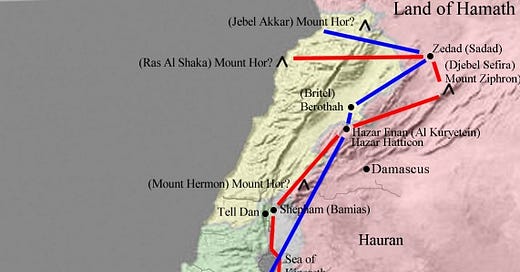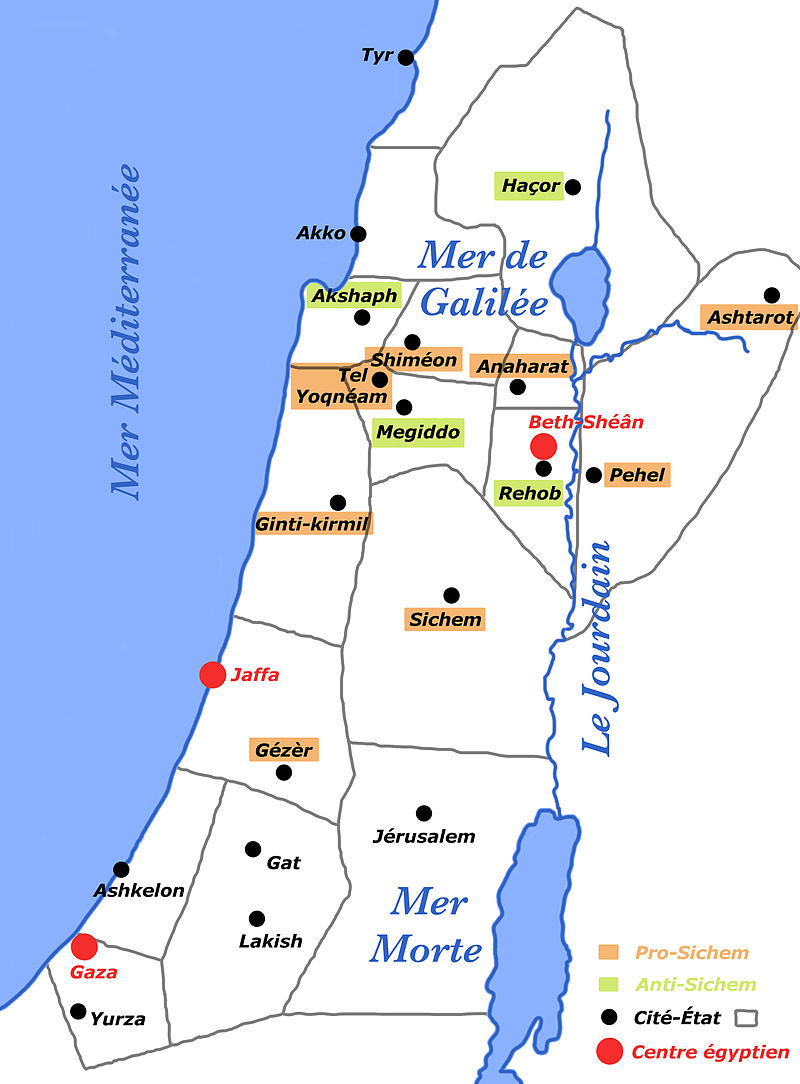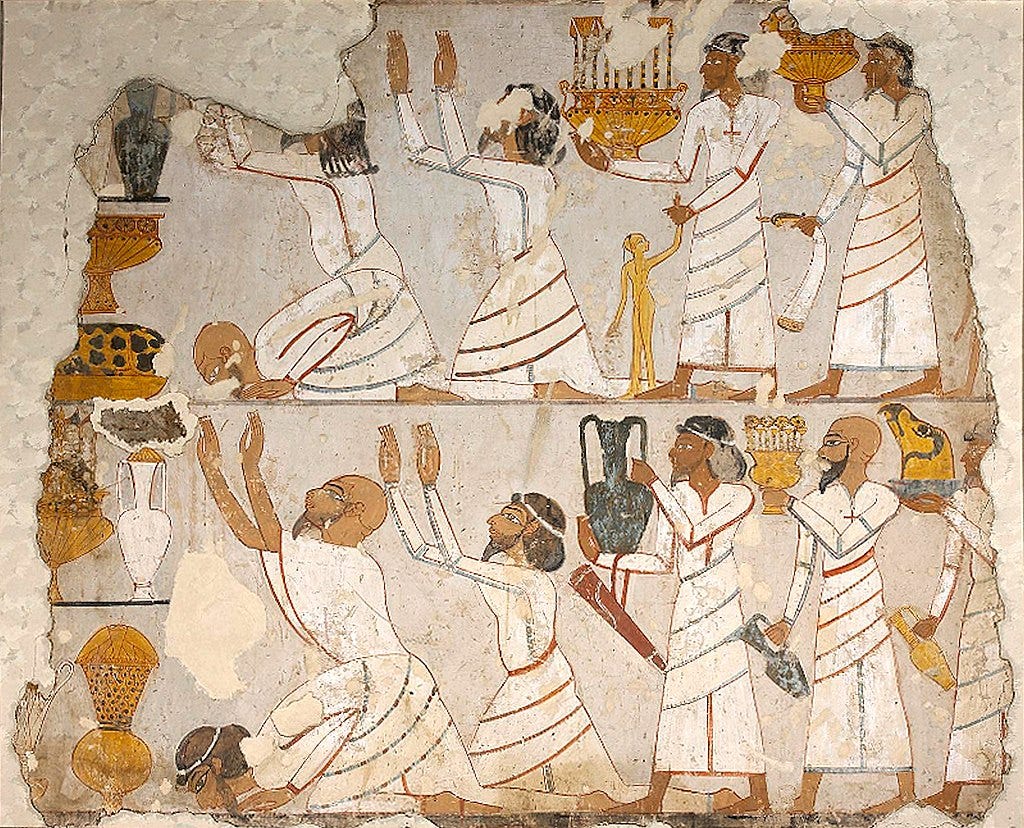And he said, "Cursed be Canaan; he shall be a slave among slaves to his brethren." Genesis 9:25
Canaan is, quite obviously, the region of Cana’an, the eventual homeland of the Jewish people, location for the Kingdom of the Israelites, dwelling of Abraham, and his descendants. While there is no confusion regarding ‘where’ Canaan is located, the actual borders of this region may be the most flexible and inaccurate of any nation mentioned. This is due to the geopolitical context of the region, with Canaan, or Israel, serving as the highway of trade between Africa, Arabia, Europe, and Mesopotamia. All four of these regions converge here, owing to the large number of empires that competed for control of the land, and owing to the complex territorial claims lasting till this day.
One of the earliest references to the region comes not in the form of ‘Canaan’, but actually through his descendants the Amorites where we get a reference to the ‘Mar.tu’, or “tent dwellers” later known as Amurru, i.e. the Amorites, in a country west of the Euphrates river. This reference is dated around 2300 BCE, but realistically this region contains the oldest inhabited city in the world, Jericho dating to 10,000 BCE, as well as the city of Megiddo known through the term “Harmageddon” dated as far back as 5000 BCE. Effectively this region was always inhabited, even if by populations not exactly fitting into modern ethnic conceptions.
During the reign of Naram-Sin of Akkad circa 2240 BCE, Amurru was termed one of the “four quarters” surrounding Akkad, along with Assyria, Sumer, and Elam. Attesting to the importance of these Amorites and their influence over Mesopotamia is a number of Amorite dynasties and even the Amorite chieftain named Sumu-abum founding the critical center of Babylon around 1894 BCE. This Babylon later grew into the famed Babylonian Empires, with the first Empire founded by the world famous Amorite known as Hammurabi between 1792-1750 BCE.
Equally important is the critical Egyptian canon Epic text called the “Story of Sinuhe” which describes the Egyptian officer, Sinuhe, performing various military activities in the region known as “Upper Retjenu” and “Fenekhu” during the reign of Senusret I around 1950 BCE. There is the obvious “Fenekhu” which is Phoencia, while “Upper” Retjenu implies there were various regions of Retjenu. Fittingly, we know of three broad regions: the southernmost known as Djahy roughly contiguous with the borders of Canaan proper depicted on the map, ‘Lebanon’ located between the Orontes and Mediterranean sea, and the North designated as “Aamu” or the obvious Amorites.
While this story is somewhat fictional, a later confirmed story from the Sebek-khu Stele during the reign Senusret III around 1862, roughly only 100 years later, confirms military campaigns to “Mentu”, “Retjenu” and “Sekmem”. The actual text is as follows: "His Majesty proceeded northward to overthrow the Asiatics. His Majesty reached a foreign country of which the name was Sekmem (...) Then Sekmem fell, together with the wretched Retenu" Sekmem, spelled “S-k-m-m” is thought to be an early reference to “Shechem” known well in the Torah. Importantly this text actually helps certify theories of the Hyksos through the term “Asiatics” referring to the people of this region. The Second Stela of Kamose actually refers to the Hyksos ruler Apepi as a “Chieftain of the Retjenu” showing the Canaanite background for these Hyksos rulers of Egypt.
As a result of their imperially competitive neighbors, the actual borders of Canaan were probably somewhat shifting, and ultimately the only defined borders are those of the later Israelites whose own borders are hotly contested to this day. It may even be possible under this geopolitical context to understand the geographic “curse” that was placed upon Canaan, due to the actions of his father Ham. While other interpretations are syncretic, one of these interpretations could be that Canaan was cursed by being the center of competing empires for the next, oh, couple millennia. Would we say that Canaan’s curse has been lifted from the territory today? Unlikely.
Dissimilar to most of the other grandchildren of Noah who are given large, prominent nations, or cultural unions, the Canaanites are given no such noble heritage. Possibly owing to the eponymous “curse”; “Canaan” never had a unified, native ruler until the time of Israel. All of Canaan’s children are mere cities, or tribes, on par with Abraham and his children who come much further down the lineage than Canaan’s sons.
A potential theory for the strange relationship of these people to their neighbors could be found in the Semitic root of the term ‘Canaan’ where the prefix ‘kn’ means "to be low, humble, subjugated".1 This term helpfully contrasts with the term ‘Aram’ meaning “highlands”, but could just as easily find its origin in the Egyptian name for the region due to its “subjugated” status during various Egyptian periods. This renaming process of the region fits the later Roman pattern of calling the region “Judea”, but following the successive revolt of the Jews changing the province's name to “Syria Palaestina”. This helps certify that Canaan was more of a geographic marker, and never a Kingdom, or distinct people. Canaan was always “subjugated” by his neighbors.
Even more interesting is that perhaps with the exception of Sidon - conveniently the first and “most important” son of Canaan - all of the other sons of Canaan have disappeared ethnically. Put and the Amazigh are still a vibrant community in the modern era, same for all of the various Cushitic nations. Egypt, contrary to popular view, does contain multiple subgroups, and whether or not they trace their origin to any of these groups, the existence of Copts, Saidis, Arabs, and more is proof “Mizraim and his sons” are still around. That cannot be said of Canaan, who has been entirely replaced by Semites, a competing son of Noah, who we will identify in the following chapter on Shem.
Continuing with the not so much theory as much as reality that Jacob’s lineage will replace the Canaanites, we can find evidence for this in Jewish Midrash recorded in Louis Ginzberg’s ‘Legends of the Jews’ where it states “The land appointed as the inheritance of the twelve sons of Jacob was provisionally granted to Canaan, Zidon, Heth, the Jebusites, the Amorites, the Girgashites, the Hivites, the Arkites, the Sinites, the Arvadites, the Zemarites, and the Hamathites. It was the duty of these nations to take care of the land until the rightful owners should come.[73]”2
It is notable that the text itself hints at the causal reason why this land was “provisional” when it notes the very inheritance of Jacob and his twelve sons. Accordingly, Jacob and his people have no original territory given to them, implying that there must be ‘somewhere’ these people would settle. The later borders of the Israelites, depicted on the map, roughly line up with the borders of the Canaanites, both “southern Djahy”, Lebanon, and in David’s period even extending north through much of the Amorite territory until the Euphrates. It is under this context we can better see the Davidic military claim as a “full” inheritance of the original “Canaan” extended beyond merely southern “Israel”.
Wilhelm Gesenius, Hebrew Lexicon, 1833








